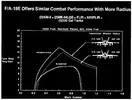ANALYSIS: Boeing pitches doubling navy's EA-18G Growler fleet
- 02 MAY, 2018
- SOURCE: FLIGHT INTERNATIONAL
- BY: GARRETT REIM
- LOS ANGELES
Stretched thinly by escort jamming responsibilities not only for its native US Navy, but also for the US Air Force and soon the US Marine Corps, the nation's 160-strong fleet of Boeing EA-18G Growlers may need to grow. That is the belief of the type's manufacturer, which is eyeing a gap in the Department of Defense's escort jamming capabilities and pitching the EA-18G as the plug.
An electronic warfare version of the F/A-18F Super Hornet, the Growler has taken on a joint service role since its introduction in 2009, covering for the USAF's lack of escort jamming aircraft: a result of the retirement of its General Dynamics EF-111A Raven without replacement in 1998. The EA-18G's role is expected to grow further as the USMC plans to retire its Northrop Grumman EA-6B Prowlers in 2019.
The USN says it currently has five EA-18G Growlers per squadron, with each air wing containing one such unit.
"Boeing believes the navy needs eight to 11 Growlers per air wing and expeditionary squadron," says Dan Gillian, the company's vice-president of F/A-18 and EA-18G programmes. "We believe there will be a need for additional Growlers to be added into the budget in upcoming years."
The Joint Staff, which is responsible for assessing cross-service needs, could not be reached for comment. The USN says its fleet of Growlers is sufficient for its own missions, but that it cannot speak for the other services.
Boeing also contends that the airborne electronic warfare platform has broader appeal than with the USA alone. So far, Australia is the only export customer to have purchased the type, with its air force taking 12.
"Any nation that faces an advanced anti-access/aerial denial threat needs a Growler,” says Gillian. “
Finland, Germany, Japan, Poland and the United Arab Emirates are some of the countries that have interest in the Growler.”
INCAPACITATING FORCE
Designed to blind an enemy by interfering with and blocking its radar and communication systems, Boeing boasts that the EA-18G is the only tactical jamming aircraft in production in the USA today.
Introduced almost 10 years ago as the navy's replacement for the EA-6B – which retired in 2015 – the Growler is built alongside E/F-model Super Hornets at Boeing's production facilities in St Louis, Missouri. The manufacturer has delivered 153 examples to the USN so far, and the last is currently expected to be received by February 2019, the service says.
The Growler has one pilot and one weapons systems officer, as opposed to its predecessor the Prowler, which had a crew of four: a pilot and three electronic countermeasures officers.
"The four-person-crew Prowler is a 1970s design and is much more aircrew-intensive," notes Cdr David Rueter, the USN's deputy programme manager for the EA-18G, who has flown both aircraft. He also notes the increased reliance on computer systems in the Growler, stating: "The aircraft does a lot more for you."
Stripped of the Super Hornet's Vulcan 20mm cannon and the wingtip-mounted Raytheon AIM-9X Sidewinder air-to-air missiles, the EA-18G is a flying transmitter. Instead of weapons, it sports an ALQ-99 jamming pod under its belly and ALQ-218 radar warning receiver pods on its wingtips. The aircraft can also carry additional ALQ-99 jamming pods under its wings, which Rueter says can be swapped out in 15min on the carrier deck to meet different mission requirements.
The aircraft also carries weapons such as the Raytheon AGM-88 High-speed Anti-Radiation Missile for use against enemy radars and two Raytheon AIM-120 AMRAAMs for self-defence.
ADVANCING THREATS
Boeing's pitch to add new Growlers to the US arsenal comes as war planners are being prompted to reconsider electronic warfare after a period of neglect and in the face of new threats.
"There was limited attention paid to electronic warfare in the 1990s across the Department of Defense," says Nicholas O'Donoughue, an engineer at Rand Corp, who specialises in radar signal processing. "The US Army, for example, got rid of its Combat Electronic Warfare Intelligence brigades, and chose not to modernise any of their equipment until it became necessary to counter IEDs [improvised explosive devices] in Iraq and Afghanistan, at which point they rapidly acquired and deployed vehicle-based jammers."
In recent years, new, sophisticated radars manufactured in China and Russia are also becoming increasingly difficult for US forces to jam, O'Donoughue says.
"The progression of improved analogue to digital converters, high-power microwave and millimetre-wave components, and active electronically scanned arrays means that a modern radar is capable of generating much more dynamic signals, which are more difficult to recognise and to counter," he says.
"This dynamic nature, and the increasing number of benign signals in the electromagnetic spectrum, makes it very difficult to accurately identify incoming signals." Improved range on surface-to-air-missiles is also making electronic warfare all the more critical, he adds.
But as adversaries' systems are improving, so, too, are the EA-18G's capabilities.
"Growlers will receive the first significant hardware upgrade in 2021," says Rueter. "This includes an improved ALQ-218(V)3 receiver system and addition of improved datalink capability provided by the Tactical Targeting Network Technology terminal and the Distributed Targeting Processor – Network.”
Boeing and the USN are also eyeing adding Super Hornet Block III upgrades to the Growler, including an advanced cockpit system and conformal fuel tanks, which would increase the range of the aircraft, allowing it to fly longer alongside strike platforms.
And both entities are also eagerly awaiting the arrival of the Next Generation Jammer, which will come in three frequency ranges and replace the ageing ALQ-99. Production of the new mid-range jammer has been awarded to Raytheon, while low- and high-band contracts have yet to be assigned.
Forthcoming improvements aside, the USN declines to comment specifically on countering adversaries' increasingly sophisticated defences with the EA-18G. It does acknowledge, however, that the changing nature of electronic warfare presents difficulties to its current fleet.
"It’s certainly a challenge, but we do the best we can," says Rueter. "It’s a cat-and-mouse game."
Flightglobal




